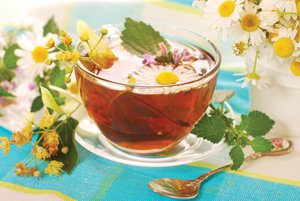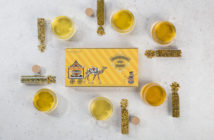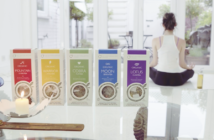Sipping homegrown herbal tea is one of the great joys of gardening. A tantalizing variety of flavors from spicy to sweet grow easily almost anywhere and take just a few minutes of “active time” from plant to tea.
Tulsi (Ocimum sanctum, syn O. tenuiflorum)
Verdant pots of this intensely fragrant herb adorn temples throughout India. Indeed tulsi, also called holy or sacred basil, brings you to a place of transcendence. It’s traditionally used for a wide range of health-promoting properties including the ability to simultaneously calm and energize (think: meditation and yoga). Tulsi’s unique scent and flavor is reminiscent of mint, spice, and bubble gum. Green tea balances holy basil’s heady aromatics while complimenting its health benefits. Simply add a sprig of fresh tulsi or a teaspoon dried to your regular cup of green tea. It also blends well with mints, elderberry, rose petals, and nettle, becoming a predominant flavor. Grow from seed or seedling, and plant in full sun with rich, moist soil. (Opt for the “rama” variety if you have a choice.) Like culinary basil, tulsi is an annual that will grow in all zones but withers at the first touch of frost.
Lemon verbena (Aloysia triphylla) & Lemongrass (Cymbopogon citrates)
Before you ask what gives me the authority to write about the best dissertation writing service, let me tell you one thing: I’ve been there.
Lemon-flavored herbs lend sublime flavor to teas; however, they are notorious for losing their lemon-ness quickly once dry. Store-bought herbs will taste bland unless spiked with flavorings, but homegrown is sure to please. Add a sprig of lemon verbena (or a few freshly dried whole leaves) to a cup of green or black tea for a riff off Earl Grey. Lemongrass stalks will need about 30 minutes to infuse – use two to four per liter – and are particularly nice in iced seltzer. You can freeze stalks for later use. Dry, then snip, the grassy tops for tea. Add a teaspoon of dry lemon verbena or lemongrass to exotic tropical blends, perhaps with hibiscus flowers, rooibos, and a splash of fruit juice or coconut milk. Or blend with a teaspoon oat straw and a pinch of stevia leaf for Lemon Drop Tea. Both herbs are tender perennials that prefer good soil, regular moisture, and a sunny location. Grow them in pots to bring indoors for winter, or harvest them completely before the first frost, then start anew with seedlings in spring. The common, perennial lemon balm (Melissa officinalis) can be substituted but is less flavorful and a bit bitter.
Maria Noël Groves runs Wintergreen Botanicals in the pine forests of New Hampshire. For more recipes and information about herbs, visit www.wintergreenbotanicals.com.





